Instructions for Side by Side Printing
- Print the notecards
- Fold each page in half along the solid vertical line
- Cut out the notecards by cutting along each horizontal dotted line
- Optional: Glue, tape or staple the ends of each notecard together
Exam 3, Chapter 20
front 1 ANTIMICROBIAL DRUGS | back 1 Treatment of disease with chemical substances. |
front 2 ANTIMICROBIAL DRUGS | back 2 Act by killing or by interfering with the growth of microorganisms. |
front 3 ANTIMICROBIAL DRUGS | back 3 The property of some antimicrobial agents to be toxic for a microorganism and nontoxic for the host. |
front 4 ANTIMICROBIAL DRUGS | back 4 A substance produced by microorganisms that in small amounts inhibits another microorganism. |
front 5 ANTIMICROBIAL DRUGS | back 5 Fleming discovered penicillin, produced by Penicillium. |
front 6 ANTIMICROBIAL DRUGS | back 6 Howard Florey and Ernst Chain performed first clinical trials of penicillin. |
front 7 THE SPECTRUM OF ANTIMICROBIAL ACTIVITY | back 7 Range of different microbial types they affect; affects either gram-positive OR gram-negative bacteria; one or the other, but not both. |
front 8 THE SPECTRUM OF ANTIMICROBIAL ACTIVITY | back 8 Antibiotics that affect a broad range of |
front 9 THE SPECTRUM OF ANTIMICROBIAL ACTIVITY | back 9 Growth of a target pathogen that has developed resistance to antibiotics; overgrowth; broad-spectrum antibiotic. |
front 10 THE ACTION OF ANTIMICROBIAL DRUGS | back 10 Kills microbes directly |
front 11 THE ACTION OF ANTIMICROBIAL DRUGS | back 11 Prevent microbes from growing; inhibits growth |
front 12 MAJOR ACTION MODES OF ANTIMICROBIAL DRUGS | back 12 1. INHIBITION OF CELL WALL SYNTHESIS: |
front 13 ANTIMICROBIAL DRUGS | back 13 PABA is the substrate for an enzymatic reaction leading to the synthesis of folic acid, a vitamin that functions as a coenzyme for the synthesis of the purine and pyrimidine bases of nucleic acids and many amino acids. |
front 14 INHIBITOR OF CELL WALL SYNTHESIS | back 14 A group of 50 chemically related antibiotics produced either by Penicillium (natural penicillins) or by adding side chains to the beta-lactam ring (semisynthetic penicillins); inhibitors of cell wall synthesis. |
front 15 INHIBITOR OF CELL WALL SYNTHESIS | back 15 1. Natural penicillin |
front 16 INHIBITOR OF CELL WALL SYNTHESIS | back 16 Penicillin extracted from cultures of the mold Penicillium exists in several closely related forms. |
front 17 INHIBITOR OF CELL WALL SYNTHESIS | back 17 1. Penicillin G: |
front 18 INHIBITOR OF CELL WALL SYNTHESIS | back 18 Part of the penicillin is produced by the mold, and part is added synthetically; attempts to overcome the disadvantages of natural penicillins. |
front 19 INHIBITOR OF CELL WALL SYNTHESIS | back 19 Changes made to the narrow spectrum of activity of natural penicillins giving them a broader-spectrum making them effective against both gram-negative and gram-positive bacteria, although they are not resistant to penicillinases. |
front 20 INHIBITOR OF CELL WALL SYNTHESIS | back 20 An approach to the proliferation of penicillinase to combine penicillins (Amoxicillin) with potassium clavulanate (clavulanic acid), which is a noncompetitive inhibitor of penicillinase with no antimicrobial activity of its own. It is a product of a Streptomycete; Penicillins + β-lactamase inhibitors (combo drug). |
front 21 INHIBITOR OF CELL WALL SYNTHESIS | back 21 1. OXACILLIN: |
front 22 β-LACTAM ANTIBIOTICS | back 22 1. Penicillinase-resistant penicillins. |
front 23 β-LACTAM ANTIBIOTICS | back 23 Substitute a Carbon atom for a Sulfur and add a double bond to the penicillin nucleus. |
front 24 β-LACTAM ANTIBIOTICS | back 24 A Single ring. |
front 25 INHIBITOR OF CELL WALL SYNTHESIS | back 25 Narrow spectrum; act against gram-positive bacteria. |
front 26 INHIBITOR OF CELL WALL SYNTHESIS | back 26 Extended spectrum includes gram-negative bacteria |
front 27 INHIBITOR OF CELL WALL SYNTHESIS | back 27 Includes pseudomonads; injected |
front 28 INHIBITOR OF CELL WALL SYNTHESIS | back 28 Oral |
front 29 INHIBITOR OF CELL WALL SYNTHESIS | back 29 1. BACITRACIN: |
front 30 INHIBITOR OF CELL WALL SYNTHESIS | back 30 1. ISONIAZID (INH): |
front 31 THE INHIBITION OF PROTEIN SYNTHESIS BY ANTIBIOTICS | back 31 STREPTOMYCIN: |
front 32 THE INHIBITION OF PROTEIN SYNTHESIS BY ANTIBIOTICS | back 32 CHLORAMPHENICOL: |
front 33 THE INHIBITION OF PROTEIN SYNTHESIS BY ANTIBIOTICS | back 33 Interfere with attachment of tRNA to mRNA-ribosome complex. |
front 34 THE INHIBITION OF PROTEIN SYNTHESIS BY ANTIBIOTICS | back 34 Occurs in translation. |
front 35 INHIBITORS OF PROTEIN SYNTHESIS | back 35 Broad spectrum; binds 50s subunit; inhibits peptide bond formation. |
front 36 INHIBITORS OF PROTEIN SYNTHESIS | back 36 Streptomycin, Neomycin, Gentamicin; broad spectrum; change shape of 30s subunit. |
front 37 INHIBITORS OF PROTEIN SYNTHESIS | back 37 Broad spectrum; interfere with tRNA attachment. |
front 38 INHIBITORS OF PROTEIN SYNTHESIS | back 38 MRSA and Acinetobacter baumanii; bind 30s subunit; inhibit translation. |
front 39 INHIBITORS OF PROTEIN SYNTHESIS | back 39 Gram-positives; bind 50s subunit; prevent translocation. |
front 40 INHIBITORS OF PROTEIN SYNTHESIS | back 40 Gram-positives; bind 50s subunit; inhibit translation. |
front 41 INHIBITORS OF PROTEIN SYNTHESIS | back 41 Linezolid; MRSA; binds 50s subunit; prevent formation of 70s ribosome. |
front 42 INHIBITORS OF PROTEIN SYNTHESIS | back 42 From the mushroom Pleurotis Mutilus; MRSA; binds 50s; prevent translocation. |
front 43 INJURY TO THE PLASMA MEMBRANE | back 43 Structural changes in the membrane, followed by arrest of the synthesis of DNA, RNA, and protein; MRSA. |
front 44 INJURY TO THE PLASMA MEMBRANE | back 44 Topical; Combined with Bacitracin and Neomycin in over-the-counter preparation. |
front 45 INHIBITORS OF NUCLEIC ACID SYNTHESIS | back 45 Inhibits RNA synthesis; anti-tuberculosis. |
front 46 INHIBITORS OF NUCLEIC ACID SYNTHESIS | back 46 Nalidixic Acid (urinary infections); Ciprofloxacin; Inhibit DNA gyrase; urinary tract infections. |
front 47 COMPETITIVE INHIBITORS | back 47 Inhibit folic acid synthesis; broad spectrum. |
front 48 ACTIONS OF THE ANTIBACTERIAL SYNTHETICS TRIMETHOPRIM AND
SULFAMETHOXAZOLE | back 48 A Sulfonamide that is a structural analog of PABA, competitively inhibits the synthesis of Dihydrofolic Acid from PABA. |
front 49 ACTIONS OF THE ANTIBACTERIAL SYNTHETICS TRIMETHOPRIM AND
SULFAMETHOXAZOLE | back 49 A structural analog of a portion of Dihydrofolic Acid, competitively inhibits the synthesis of Tetrahydrofolic Acid. |
front 50 ANTIFUNGAL DRUGS: INHIBITION OF ERGOSTEROL SYNTHESIS | back 50 Amphotericin B. |
front 51 ANTIFUNGAL DRUGS: INHIBITION OF ERGOSTEROL SYNTHESIS | back 51 Miconazole; Triazole. |
front 52 ANTIFUNGAL DRUGS: INHIBITION OF ERGOSTEROL SYNTHESIS | back 52 For Azole-resistant infections. |
front 53 ANTIFUNGAL DRUGS: INHIBITING CELL WALL SYNTHESIS | back 53 Inhibit synthesis of β-glucan; Cancidas is used against Candida and Pneumocystis. |
front 54 INHIBITION OF NUCLEIC ACIDS | back 54 Cytosine analog interferes with RNA synthesis. |
front 55 INHIBITION OF NUCLEIC ACIDS | back 55 Anti-Pneumocystis; may bind DNA. |
front 56 OTHER ANTIFUNGAL DRUGS | back 56 Inhibits microtubule formation; superficial dermatophytes. |
front 57 OTHER ANTIFUNGAL DRUGS | back 57 Action unknown. |
front 58 THE STRUCTURE AND FUNCTION OF THE ANTIVIRAL DRUG ACYCLOVIR | back 58 A) Acyclovir structurally resembles the nucleoside deoxyguanosine. |
front 59 ANITVIRAL DRUGS | back 59 Indinavir: |
front 60 ANITVIRAL DRUGS | back 60 HIV |
front 61 ANITVIRAL DRUGS | back 61 Amantadine: |
front 62 ANITVIRAL DRUGS | back 62 1. Zanamivir: |
front 63 ANITVIRAL DRUGS: INTERFERONS | back 63 1. Prevent spread of viruses to new cells. |
front 64 ANITVIRAL DRUGS: INTERFERONS | back 64 Promotes interferon production. |
front 65 ANTIPROTOZOAN DRUGS | back 65 Inhibits DNA synthesis; Malaria. |
front 66 ANTIPROTOZOAN DRUGS | back 66 Kills Plasmodium sporozoites. |
front 67 ANTIPROTOZOAN DRUGS | back 67 Interferes with anaerobic metabolism; Trichomonas an Giardia. |
front 68 ANTIHELMINTHIC DRUGS | back 68 Prevents ATP generation; tapeworms. |
front 69 ANTIHELMINTHIC DRUGS | back 69 Alters membrane permeability; flatworms. |
front 70 ANTIHELMINTHIC DRUGS | back 70 Interfere with nutrient absorption; intestinal roundworms. |
front 71 ANTIHELMINTHIC DRUGS | back 71 Paralysis of helminthes; intestinal roundworms. |
front 72 ANTIBIOTIC RESISTANCE | back 72 1. A variety of mutations can lead to antibiotic |
front 73 BACTERIAL RESISTANCE TO ANTIBIOTICS | back 73 1. Blocking entry. |
front 74 ANTIBIOTIC RESISTANCE | back 74 1. Misuse of antibiotics selects for resistance |
front 75 EFFECTS OF COMBINATIONS OF DRUGS | back 75 Occurs when the effect of two drugs together is greater than the effect of either one alone; work with each other. |
front 76 EFFECTS OF COMBINATIONS OF DRUGS | back 76 Occurs when the effect of two drugs together is less than the effect of either one alone; work against each other. |
front 77 ANTIBIOTIC SAFETY | back 77 Therapeutic index: |
front 78 FUTURE CHEMOTHERAPEUTIC AGENT | back 78 Broad spectrum antibiotics: |
front 79 FUTURE CHEMOTHERAPEUTIC AGENT | back 79 Phage therapy |
front 80 GENE SILENCING COULD PROVIDE TREATMENTS FOR A WIDE RANGE OF DISEASES | back 80 1. An abnormal gene, cancer gene, or virus gene is |
front 81 The first antibiotic discovered was: | back 81 Penicillin. |
front 82 Which of the following antibiotics inhibits cell wall synthesis? | back 82 Cephalosporin. |
front 83 Which of the following antibiotics inhibits protein synthesis? | back 83 Streptomycin. |
front 84 Which of the following is not used for treating bacterial infections? | back 84 Griseofulvin. |
front 85 Which antimicrobial works by inhibiting the synthesis of mycolic
acid? | back 85 Isoniazid. |
front 86 Which of the following antibiotics should be prescribed as a first
choice for a streptococcal infection? | back 86 Amoxicillin. |
front 87 Which of the following antibiotics inhibits folic acid synthesis? | back 87 Sulfanilamide. |
front 88 Which of the following drugs inhibits the synthesis of mRNA in
bacteria? | back 88 Rifampin. |
front 89 Which of the following antibiotics frequently used as an alternative
for those who are allergic to penicillin? | back 89 Erthryomycin. |
front 90 All of the following antibiotics inhibit protein synthesis except: | back 90 Bacitracin. |
front 91 Which drug would be used to treat athlete's foot? | back 91 Clotrimazole. |
front 92 Which antifungal drug is commonly used for systemic fungal
infections? | back 92 Fluconazole. |
front 93 Tetracyclines are effective against all of the following except: | back 93 Fungi. |
front 94 A nucleoside analog used to treat HIV infection is: | back 94 Zidovudine. |
front 95 All of the following are anti-protozoan drugs except: | back 95 Mebendazole. |
front 96 Which drug is not a nucleoside analog? | back 96 Neviraprine. |
front 97 Which is the drug of choice for the treatment of malaria? | back 97 Chloroquine. |
front 98 The drug, Flagyl, is commonly used to treat an STD caused by: | back 98 Trichomonas vaginalis. |
front 99 Which of the following mechanisms is antifungal? | back 99 Inhibit ergosterol synthesis. |
front 100 Which of the following is used for treating influenza infections? | back 100 Oseltamivir. |
front 101 Antibiotic resistance can be minimized by the discriminating use of
drugs in appropriate dosages. | back 101 True |
front 102 The MIC is the lowest concentration of drug capable of preventing
microbial growth. | back 102 True |
front 103 It is relatively easy to find drugs that are effective against
eukaryotic pathogens. | back 103 False |
front 104 Bacteriostatic agents are ineffective as antibiotics. | back 104 False |
front 105 Some drug combinations are antagonistic, therefore, when taken
together they are more effective. | back 105 False |
front 106 Semisynthetic penicillins are more effective antibiotics than natural
penicillin. | back 106 True |
front 107 In 1928, Alexander Fleming observed that the growth of the bacterium
Staphylococcus aureus was inhibited by a mold thereby discovering the
first antibiotic. | back 107 True |
front 108 Because antifungal drugs like amphotericin B target sterols in the
plasma membrane they are ineffective as antibacterial drugs. | back 108 True |
front 109 Ivermectin is an anti-protozoan drug. | back 109 False |
front 110 A drug that inhibits translation at 70S ribosomes can be used to
treat human viral infections. | back 110 False |
front 111 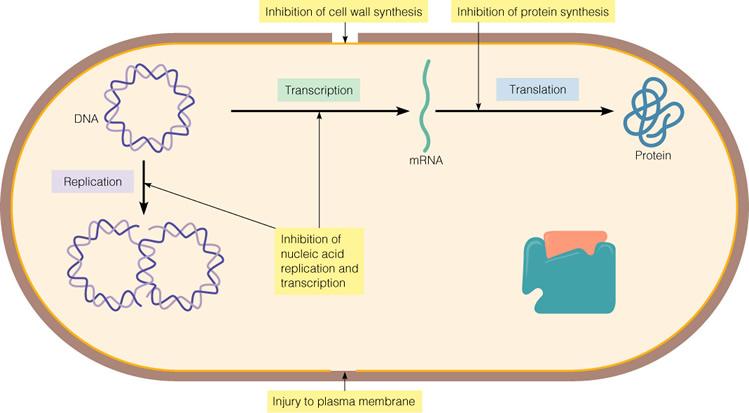 Which mode of antibiotic activity is the most selective target for
antibiotics since it will not affect eukaryotic cells? | back 111 Inhibition of cell wall synthesis |
front 112 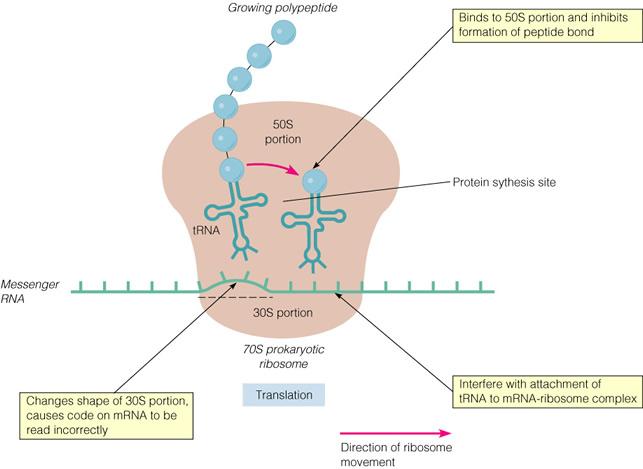 Which of these antibiotics exerts its activity by changing the shape
of 30S portion, causing the code on mRNA to be read incorrectly? | back 112 Streptomycin |
front 113 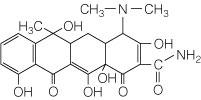 Which antibiotic pictured is not recommended for children due to
possible discolorations of their teeth? | back 113 Tetracycline |
front 114 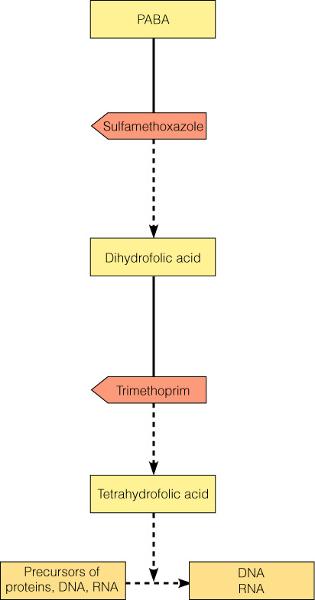 All of the following are correct about the combination of
trimethoprim and sufamethoxazole (TMP-SMZ) EXCEPT: | back 114 The drugs in combination are antagonistic. |
front 115  Which of the following is correct about amphotericin B shown in the
figure? | back 115 The drug belongs to the polyene group of antifungals. |
front 116  Which antibiotic shown in the figure appears to cause aplastic anemia
in 1 in 500,000 individuals? | back 116 Chloramphenicol |
front 117 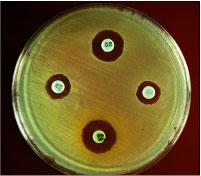 In the disk-diffusion assay shown in the photo, what do the clear
areas around the discs represent? | back 117 Where bacterial growth has been inhibited. |
front 118  FIGURE A | back 118 Figure B |
front 119 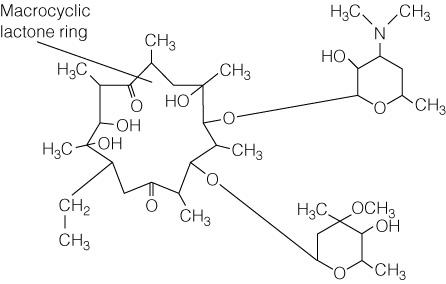 FIGURE B | back 119 SEE QUESTION 116 |
front 120  FIGURE C | back 120 SEE QUESTION 116 |
front 121 A disk-diffusion test identifies: | back 121 Agents to which a test culture is susceptible. |
front 122 A chemical that kills gram-positive bacteria and gram-negative
bacteria is described as: | back 122 Broad spectrum. |
front 123 A drug that inhibits peptidoglycan synthesis is: | back 123 Antibacterial. |
front 124 A drug that inhibits mitosis might be useful against all of the
following infections except which type? | back 124 Bacterial. |
front 125 Clindamycin binds to the 50S ribosomal subunit to inhibit
translocation. This antibiotic stops: | back 125 Translation in prokaryotes. |
front 126 Gentamicin binds to the 30S ribosomal subunit to cause misreading of
mRNA. This antibiotic stops: | back 126 Translation in prokaryotes. |
front 127 A drug that binds with sterols would injure: | back 127 Eukaryotic plasma membranes. |
front 128 The method of action of nucleoside analogs is: | back 128 Competitive inhibition. |
front 129 Ethambutol inhibits incorporation of mycolic acid into: | back 129 Cell walls. |
front 130 Ethambutol inhibits incorporation of mycolic acid, therefore it is
effective against: | back 130 Mycobacteria. |
front 131 You have a 200 mg/ml antibiotic solution. You prepare serial
dilutions (1:2, 1:4, etc.) of the antibiotic; the first tube contains
100 mg/ml. You then inoculate each tube with Salmonella. Bacteria grow
in tubes 4, 5, and 6. You subculture bacteria from tubes 1 through 3
to nutrient broth. Growth occurs in the tube 3 subculture. You can
conclude that the MIC is: | back 131 25 mg/ml. |
front 132 You have a 200 mg/ml antibiotic solution. You prepare serial
dilutions (1:2, 1:4, etc.) of the antibiotic; the first tube contains
100 mg/ml. You then inoculate each tube with Salmonella. Bacteria grow
in tubes 4, 5, and 6. You can conclude that the MBC is: | back 132 Cannot tell from the information provided. |
front 133 You have a 200 mg/ml antibiotic solution. You prepare serial
dilutions (1:2, 1:4, etc.) of the antibiotic; the first tube contains
100 mg/ml. You then inoculate each tube with Salmonella. Bacteria grow
in tubes 4, 5, and 6. You subculture bacteria from tubes 1 through 3
to nutrient broth. Growth occurs in tubes 2 through 3. You can
conclude that the MBC is: | back 133 100 mg/ml. |
front 134 Which one of the following pairs is not correctly matched? | back 134 Ciprofloxacin-inhibit cell wall synthesis. |
front 135 You obtain the following zones of inhibition (ZI) from a
disk-diffusion test on Staphylococcus aureus. Antibiotic A, ZI = 0 mm;
Antibiotic B, ZI = 23 mm; Antibiotic C, ZI = 16 mm. Which antibiotic
is bacteriostatic? | back 135 Cannot tell from the information provided. |
front 136 Rifampin blocks RNA polymerase to inhibit: | back 136 Transcription. |
front 137 Antisense DNA will combine with a pathogen's DNA to: | back 137 Inhibit transcription. |
front 138 Polyenes, azoles, and allyamines interfere with sterol synthesis.
These drugs will affect: | back 138 Fungi. |
front 139 Which of the following statements is true about superinfections? | back 139 They are caused by antibiotic-resistant bacteria. |
front 140 Sulfa drugs are selective against bacteria for all of the following
reasons except which? | back 140 Sulfa drugs cause production of antimetabolites. |